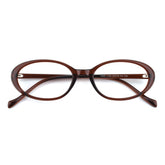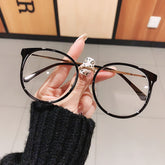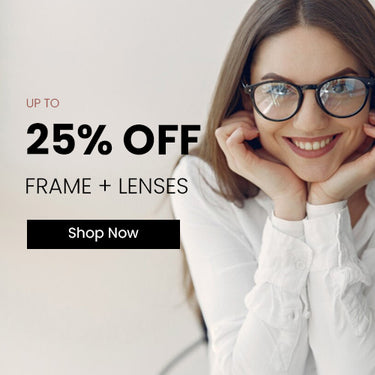5 Signs You Should Get High Index Lenses
High index lenses are thinner than traditional options and can offer a number of benefits to glasses wearers. That’s especially true for people with high-strength prescriptions — you’re not stuck with Coke-bottle lenses if you don’t want them. Find out more about high index lenses below, including five signs it might be time to check them out for yourself.
High index lenses are thinner than traditional options and can offer a number of benefits to glasses wearers. That’s especially true for people with high-strength prescriptions — you’re not stuck with Coke-bottle lenses if you don’t want them. Find out more about high index lenses below, including five signs it might be time to check them out for yourself.
WHAT ARE HIGH INDEX LENSES?
High index lenses are made out of a specific type of plastic, unsurprisingly called high index plastic. This material and the way the lenses are formed causes light to be refracted in a unique way, and that refraction allows for a stronger prescription to be packaged in a much thinner lens than you’d be able to get using other materials.
People often get high index lenses confused with polycarbonate lenses. This is due in part to the popularity of polycarbonate in the 1980s and beyond. Polycarbonate material is extremely strong and can hold up to rougher wear than some other materials, which is why it’s still recommended today for people who engage in rugged activity or work. It’s also still recommended for children due to the fact that it’s less likely to crack.
THE BENEFITS OF HIGH INDEX LENSES
The overall benefit of high index lenses is that they’re thinner. Specifically, if you have a prescription lens in high index material, it’s going to be thinner than the same prescription in a traditional lens material. Here are just a few reasons that matters:
- The lenses are less noticeable. Thinner lenses are less noticeable and allow for a wider range of frame options. If you’re someone who has a high prescription, then you might have been unable to wear semi-rimless browline frames or very delicate wire frames before. With high index options, those frames and more are now available to you. This puts you more in control of your eyewear and helps you accent your face with a functional accessory that adds to your fashion rather than takes away from it.
- The glasses can be lighter. Thinner lenses also result in potentially lighter glasses, which are often found to be more comfortable as they reduce the impact of the pressure points on the bridge of the nose and ears. Wearing lighter glasses can also help ensure that they stay in place even when you’re somewhat active, so you’re not relying on uncomfortable bands to hold them in place or constantly pushing them up or adjusting them.
- The “bug-eyed” look is diminished or not present at all. Extremely thick lenses can give someone a bug-eyed look, which occurs because the image of your eye is changed as it passes back through the thick lens to the outside viewer on the other side. Because high index lenses are thinner, the bug-eye issue is dramatically reduced in many cases. The way the lenses are cut (due to the unique way high index lens material refracts light) also helps with this.
WHY NOT GET HIGH INDEX LENSES?
The benefits of high index lenses might sound awesome, but consider whether they’re yours for the reaping — not everyone will see these improvements. If your prescription is very minor, you probably have fairly thin lenses regardless of the material, and paying for high index lenses might mean more expensive glasses without much added benefit.
Though they provide a great many advantages for those in need, high index lenses aren’t the right choice for everyone. For example, polycarbonate lenses are significantly more impact-resistant and may therefore be a better choice for children’s glasses. High index lenses are also more limited with respect to tinting, so if you’re looking for a dark-tinted lens, they’re unlikely to be a good match.
5 SIGNS YOU MIGHT NEED HIGH INDEX LENSES
If you’re up in the air about whether the upgrade is worthwhile, it can be helpful to consider your unique circumstances.
Here are five signs that you stand to benefit from making the upgrade to high index lenses:
1. YOUR PRESCRIPTION IS FAIRLY STRONG
While anyone can wear high index lenses, they’re usually recommended for someone who has a very strong vision prescription since, typically, a stronger prescription means a thicker traditional lens. Changing to high index lenses can mean cutting that thickness in half (or more)!
Talk to your vision care provider about your prescription and whether it’s considered to be high-strength. You can also ask your optometrist for a recommendation regarding lens type and what might be right for you. Contrary to popular belief, your sphere power isn’t the only factor that can go into this decision. If you have astigmatism or another vision issue, you might benefit from a particular type of lens even if your prescription is relatively low-strength.
2. YOU’RE TIRED OF WEARING HEAVY GLASSES THAT WON’T STAY PUT
If your glasses feel heavy all the time or they’re always sliding down your nose, you might benefit from lighter lenses.
Before you invest in new lenses, though, do make sure your frames fit and are adjusted correctly. Sometimes, glasses fall or slide because they aren’t adjusted correctly around the ears or at the bridge of the nose. Your glasses should never feel like they’re clinging to your face, but they should rest stably even when you’re walking or running at a light pace.
If you’re sure your frames fit correctly and it’s their weight that’s pulling them down, high index lenses are a great way to mitigate that problem. To get the added benefit of a lighter weight eyewear experience, we suggest looking into lightweight glasses as well.
3. YOU’RE FRUSTRATED BY A “BUG-EYE” EFFECT
Most people want to look their best when they go out into the world. Whether you want to be able to meet someone’s gaze and impress them in the boardroom or you want to be confident in your looks for an upcoming date night, you want to be sure that you feel good about how your glasses look.
Thick lenses have significant curvature, and that can cause a bug-eyed appearance. Because of their aspheric design, high index lenses aren’t as thick at the center — in other words, they don’t have this problem. If you find yourself frustrated by the bug-eyed distortion caused by your thick lenses, then high index replacements are the way to go.
4. YOU WANT MORE CHOICES IN GLASSES FRAMES
Have you ever picked out a pair of frames that you loved and think look fabulous on your face only to be told that they won’t work with your lens needs? That’s typically because you need thicker lenses than those frames are able to support. Sometimes, even though a frame may technically support the lens, the excess sticking out of the frame may look weird or cause a functionality problem. This may often be the case with thin frames made from materials like metal.
High index lenses are thinner and lighter, so they work with more frames. This can be a good choice if you want more options or have your heart set on a certain pair of frames.
5. YOU’RE DEALING WITH UNEXPLAINED EYE STRAIN
Did you know that corrective lenses can cause some eye strain even if you have the right prescription? There’s a lot going on with your glasses that you might not normally think about, including light being refracted in a way that allows your eyes to focus on and view items that are near or far away properly.
Any use of your eyes is naturally going to provide some strain. You can’t walk all day without feeling something, even if it’s only a mild fatigue, and you can’t use your eyes all day without the same thing happening. But when you wear corrective lenses, that issue can be magnified slightly.
Higher-index lenses — especially for strong prescriptions — might be able to reduce some of that strain on your eyes because of the way that these extra-refractive lenses disperse light. If you find your eyes seem to have above average sensitivity to light, high index lenses may be the solution for your eye strain issues.
Eye strain can be an indicator of other issues, though. Make sure you talk to your eye doctor about any problems you’re experiencing to ensure other risks are ruled out. Then, you might consider trying high index lenses to see if you can get better performance out of them.
For those with thick lenses who are tired of dealing with the downsides, high index options can certainly take a load off. If you’ve decided that they’re right for you, then consider taking advantage of free high index lenses from sllac — available to people who have stronger prescriptions.











